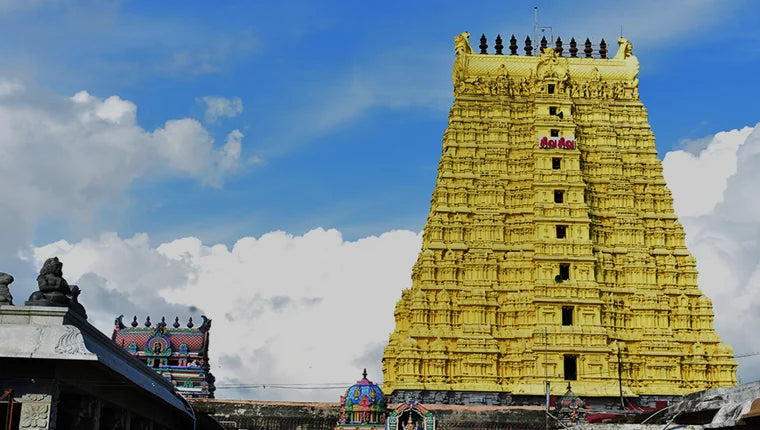
Guide to Ramanathaswamy Jyotirlinga in Rameshwaram
Since ancient times, India has been known as a land of faith and devotion, where people seek divine blessings before starting a new journey in life. One such deeply revered place is the Ramanathaswamy Temple, also known as Rameshwaram Temple, a site rich in history, mythology, and spiritual significance.
About Ramanathaswamy Temple
| Category | Details |
|---|---|
| Location | Rameshwaram, Tamil Nadu |
| Main Deity | Lord Shiva |
| Also Known As | Irāmanātasvāmi Kōyil (House of Ramanathaswamy) |
The Ramanathaswamy Temple is a sacred Hindu shrine dedicated to Lord Shiva, one of the supreme deities in Hinduism. The name Rameshwaram itself is derived from Sanskrit, meaning “Lord of Rama,” referring to Lord Shiva. This temple holds immense spiritual significance, as it is believed to have been worshipped by Lord Rama himself before his battle against Ravana.
Ramanathaswamy Temple Timings
The Ramanathaswamy Temple is open for devotees every day with the following schedule:
| Darshan Timings | Time |
|---|---|
| Morning Darshan | 5:00 AM – 1:00 PM |
| Evening Darshan | 3:00 PM – 9:00 PM |
Special pujas and abhishekam may have different timings, so it’s best to check with the temple authorities before planning your visit.
Significance of Ramanathaswamy Temple
The temple is one of the 12 Jyotirlingas, where Lord Shiva is said to have manifested as a pillar of divine light. It is also a part of the original Char Dham Yatra, along with Badrinath, Puri, and Dwarka. According to Hindu belief, visiting these sacred sites at least once in a lifetime is a path to salvation.
The temple is also among the 275 Paadal Petra Sthalams, praised in the hymns of Tamil Saivite saints (Nayanars). It is also linked to the floating stones of Ram Setu, which are said to have been used by Lord Rama’s army to build a bridge to Lanka.
Experience a Spiritual Journey with Yatraveda
For those seeking a pilgrimage to Ramanathaswamy Temple, our travel partner Yatraveda offers well-organized Rameshwaram temple tours. From transportation and comfortable accommodations to guided temple visits, Yatraveda ensures a seamless spiritual journey for devotees.
Perform Pooja from Anywhere with Mantraseva
Can't visit the temple in person? Through Mantraseva, we offer virtual pooja services at Ramanathaswamy Temple. Whether you are an NRI or unable to travel, you can book special poojas and aartis, ensuring your prayers reach the divine.
Ramanathaswamy Temple History & Legends
According to the Ramayana, after defeating Ravana, Lord Rama sought forgiveness for killing a Brahmin (Ravana). He worshipped Lord Shiva at this temple and installed a Shivling. When Hanuman delayed in bringing the lingam from Kashi, Maa Sita made a Shivling from sand, which is worshipped as Ramanathar. Hanuman’s lingam, known as Kasilingam or Hanumanlingam, is also enshrined here.
Architectural Marvel of Ramanathaswamy Temple
The temple is renowned for its massive corridors, measuring about 400 feet in length on the east-west side and 640 feet on the north-south. The Rajagopuram, the temple’s main tower, stands at 53 meters, making it one of the most impressive structures in South India.
Sacred Tirthas and Rituals
The temple has 64 Tirthas (holy water bodies), of which 22 are inside the temple premises. Devotees believe that bathing in these waters purifies the soul. The first and most important is Agni Theertham, located in the sea, where devotees take a holy dip before entering the temple.
How to Get Darshan at Ramanathaswamy Temple?
· Take a dip in Agni Theertham (sea).
· Pass through 22 sacred wells for ritual cleansing.
· Change into dry clothes and proceed to the sanctum for darshan.
· Visit the Kasilingam (Hanumanlingam) before Ramanathar (Ramalingam), as per temple traditions.
Best Time to Visit
Avoid summers as Rameshwaram is hot and humid. The ideal time is between July to March, especially during monsoons and winter. Avoid peak festival days if you prefer less crowded visits.
How to Reach Ramanathaswamy Temple
· By Air: Nearest airport – Madurai (175 km)
· By Train: Rameshwaram railway station is just 2 km from the temple.
· By Road: Well-connected to major cities like Madurai, Thanjavur, and Tiruchirapalli.
Frequently Asked Questions
Ques. What is the meaning of Irāmanātasvāmi Kōyil?
Ans. It means "House of Ramanathaswamy," referring to Lord Shiva, the deity of the temple.
Ques. Why is Rameshwaram important in Hinduism?
Ans. It is one of the 12 Jyotirlingas and a part of the Char Dham pilgrimage, making it one of the holiest Hindu shrines.
Ques. Can NRIs perform pooja at the temple?
Ans. Yes, through Mantraseva, NRIs can book virtual pooja services at the temple.
Ques. What is the significance of the 22 wells inside the temple?
Ans. The 22 wells represent the 22 arrows in Lord Rama’s quiver and hold sacred water believed to cleanse sins.
Ques. How can I book a Rameshwaram temple tour?
Ans. You can book a spiritual tour through Yatraveda for a seamless pilgrimage experience.
Ques. What rituals are performed at the Ramanathaswamy Temple?
Ans. Devotees perform special Abhishekam, Rudrabhishek, and Archana. Bathing in the Agni Theertham and 22 temple wells is also a significant ritual.
Ques. Can I visit Rameshwaram with my family?
Ans. Yes, Rameshwaram is a family-friendly pilgrimage destination and offers a peaceful spiritual experience for all age groups.
Ques. Are there any dress code requirements for visiting the temple?
Ans. While there is no strict dress code, traditional attire is preferred. Men usually wear dhoti and angavastram, while women wear saree or salwar kameez.
Final Thoughts
Visiting Ramanathaswamy Temple is a spiritually enriching experience. Whether you plan to visit Yatraveda in person or perform a virtual pooja with Mantraseva, you can seek Lord Shiva’s blessings no matter where you are. Don’t miss this chance to connect with the divine at one of India’s most revered temples!


